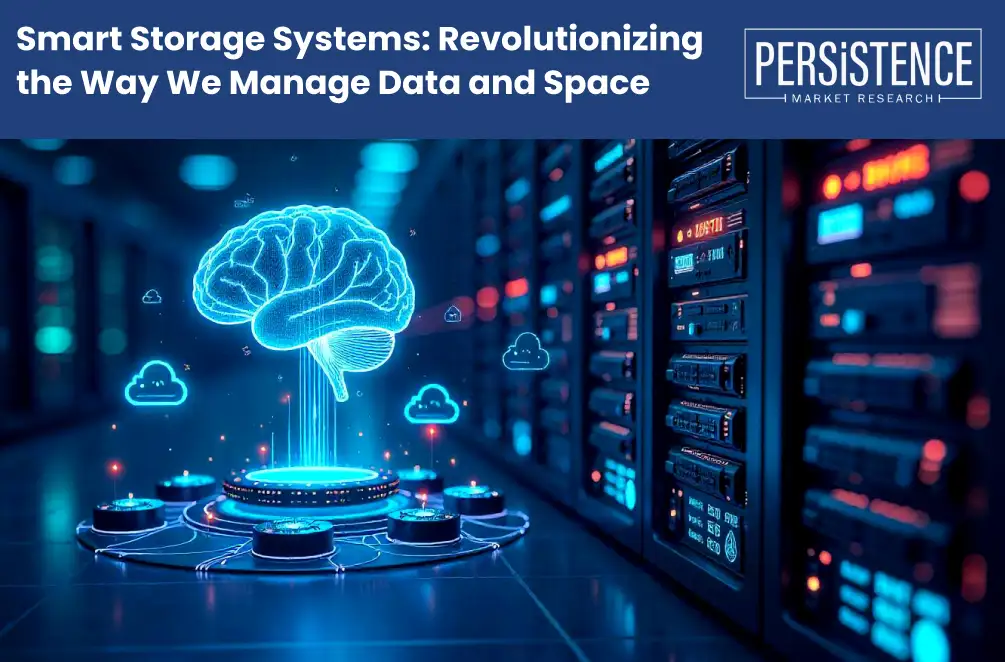- Blog
- Smart Storage Systems Data Management
Smart Storage Systems: Revolutionizing the Way We Manage Data and Space
Published On : 7 Jul 2025
What are smart storage systems and why do they matter?
In a world overflowing with data and limited physical space, smart storage systems are emerging as game-changers. Unlike traditional storage solutions that simply hold data, smart storage systems are intelligent, connected, and proactive. They integrate technologies such as sensors, artificial intelligence, and cloud computing to monitor, analyze, and adapt in real time. These systems can predict future needs, enhance security, and automate management tasks - essentially acting like a digital brain that keeps your data safe, accessible, and optimized.

The journey of storage technology.
Storage technology has evolved significantly over the years. We began with magnetic tapes and hard drives, moved on to server-based storage, and eventually adopted more advanced systems such as Network-Attached Storage (NAS) and Storage Area Networks (SAN). Today, we’re witnessing a shift toward intelligent storage solutions powered by AI, IoT, and cloud computing. This evolution reflects a broader trend, from static, hardware-based storage to dynamic, software-driven systems that are faster, more secure, and highly adaptable.
Why is smart storage so beneficial for organizations?
Smart storage systems have numerous advantages that extend beyond data storage. They make data management more efficient and flexible, enabling organizations to scale rapidly as their data expands. Increased security features ensure that sensitive information is protected from cyber threats, and smart resource management results in substantial cost reductions and energy conservation. Such systems also enhance resilience, which makes them recover faster following failures and reduces disruptions. For example, large data centers now rely on smart storage to maintain smooth and secure operations around the clock.
What technologies power smart storage systems?
- The Internet of Things (IoT) connects sensors and devices to monitor environmental conditions such as temperature and humidity, helping prevent damage and optimize space usage.
- Artificial intelligence and machine learning analyze usage patterns to predict future storage needs and automate tasks such as data distribution, backup, and recovery.
- Cloud computing offers flexible expansion and remote access, while edge computing enables real-time data processing close to the source.
- Analytics and visualization tools provide dashboards with real-time insights, helping teams monitor system health and plan capacity more effectively.
Types of smart storage systems:
Smart storage systems come in various forms, each suited to different needs. Network-Attached Storage (NAS) devices are simple, network-connected units that now include smart features such as automatic backups and security monitoring, making them ideal for small businesses and home users.
Storage Area Networks (SAN) are high-speed networks that link multiple storage devices, commonly used by large enterprises. These are evolving with intelligent management tools that balance loads and optimize performance.
Software-Defined Storage (SDS) separates storage software from hardware, offering flexibility and cost savings through AI-driven automation. Modular and scalable systems are designed to grow with your needs, allowing easy expansion without a complete overhaul, perfect for businesses that need to adapt quickly.
Where are smart storage systems making the biggest impact?
Smart storage systems are transforming industries across the board. In data centers, companies like Google use AI to manage storage and optimize energy consumption, ensuring smooth operations while conserving resources. In healthcare, hospitals generate vast amounts of sensitive data, and smart storage helps secure this information while ensuring quick access to it when needed. Retail and e-commerce platforms, such as Amazon, rely on smart storage to handle massive volumes of product images, customer data, and transaction records, especially during peak seasons. In manufacturing, smart storage enables real-time analysis of machine data, predicting failures, and scheduling maintenance to keep production lines running efficiently.
What challenges lie ahead?
Despite their many advantages, smart storage systems face several challenges. Security remains a top concern, especially with sensitive data being a prime target for cyberattacks. Integrating smart storage with existing legacy systems can be complex and expensive, and organizations often struggle to balance the initial investment with long-term benefits. Looking ahead, the industry can expect greater adoption of AI and automation to streamline storage management even further. Edge storage solutions will become more prevalent, supporting real-time workloads in remote or fast-paced environments. As industry standards evolve, integration will become easier, making smart storage accessible to a wider range of organizations.
Industry Report

Request Report Sample
Your privacy is important to us; your data is secure
Contact Us
Latest Reports
-
In-Mold Coating Market by Product Type (Water-based, Solvent-based, Powder, Other), Substrate (Thermoplastics, Thermosetting), Industry (Electronics & Appliances, Automotive & Transport, Sanitary Products, Building & Construction, Other), and Regional Analysis for 2025 - 2032
-
Automotive Active Health Monitoring Systems Market by System Location (Driver’s Seat and Dashboard), by Component (Sensors, Software and Hardware), Application Outlook (Pulse Rate, Blood Sugar Level, Blood Pressure and Misc.), End-user (Passenger Car, LCV and HCV) and Regional Analysis for 2025 - 2032
-
Medical Oxygen Cylinders Market by Product (Fixed Medical Oxygen Cylinders and Portable Medical Oxygen Cylinders), by End-user (Hospitals, Specialty Clinics, Ambulatory Surgery Centers, and Home Care Settings and Others), and Regional Analysis from 2025 - 2032
-
Temporary Cardiac Pacing Wires and Leads Market by Product (Cardiac Pacing Wires and Cardiac Pacing Leads), by Application (Cardiothoracic Surgeries, Acute Myocardial Infarction, Bradycardia, Heart Blocks, Sick Sinus Syndrome, and Congestive heart failure (CHF)), Technique (Epicardial Pacing, Transvenous Pacing, and Transcutaneous Pacing), Age Group (Pediatric, and Adult), by End-user, and Regional Analysis from 2025 - 2032
-
Hospital Acquired Pneumonia Prevention Market by Product (Oral Care Kits, Toothbrush, Vaccines, Swab, Moisturizer, Mouth Wash, Suction Tools, and Others), End User (Hospitals, Rehabilitation Centers, Ambulatory Surgery Centers, Home Care Settings, and Others), and Regional Analysis from 2025 to 2032
